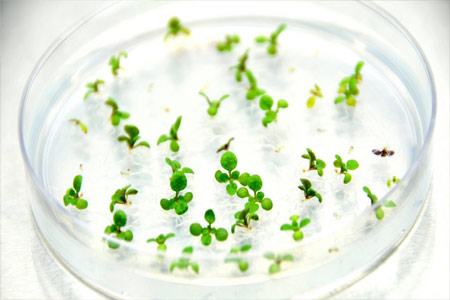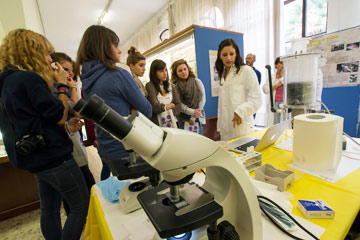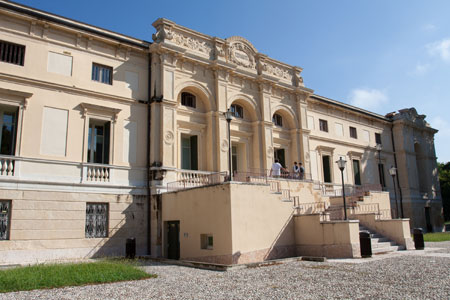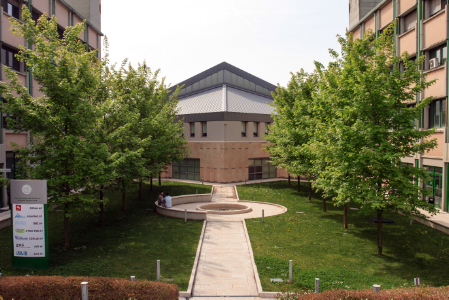Learning outcomes
The course is designed to provide the student with the knowledge of basic histology, taking into special consideration what will be useful in future for understanding and deepening of biomedical problems.
1 The study of Cytology
2 The study of histology:
Epithelial tissues (lining and glandular).
Connective tissue (dense and loose/areolar, fat, cartilage, bone, hematopoietic / vascular).
Muscle tissue (smooth, skeletal, cardiac).
Nervous tissue (central and peripheral).
Book:
JUNQUEIRA'S Basic Histology - Text & Atlas (12th Edition)
Anthony L. Mescher
McGraw Hill Lange
Syllabus
A. CYTOLOGY
1. Definition of prokaryotic and eukaryotic cells.
2. Definition of the different subcellular compartments.
3. Definition, morphology and functional roles of plasma membrane, cytosol, ribosomes, endoplasmic reticulum (ER), smooth and rough, Golgi apparatus, transport vesicles, mitochondria, cytoskeleton, components of the nucleus
4. Definition, morphology and functional roles of mitosis, meiosis, and the mitotic cell cycle.
5. Definition, morphology and functional roles of apoptosis or programmed cell death, necrosis and autophagy.
6.Histogenesis and organogenesis.
B.HISTOLOGY: Epithelial tissue
1.Covering or Lining Epithelia
General characteristics, distribution, and functional roles
Classification criteria:
squamous, simple and stratified ;
cuboidal, simple and stratified;
columnar, simple, pseudostratified and stratified;
transitional (urothelium).
Description of histological and cytological features of each type of lining epithelium with examples as visible to light microscopy (LM) and electron m. (EM).
2. Glandular Epithelia
Exocrine glands:
the classification criteria:
-simple & compound glands;
-holocrine, apocrine, merocrine glands;
-serous and mucous glands.
Description of histological and cytological features of each type of exocrine gland with examples as visible to light microscopy (LM) and electron m. (EM).
Endocrine glands: cytological and histological characteristics of adenohypophysis, neurohypophysis, thyroid, parathyroid, adrenal glands (cortex and medulla), pancreatic islets of Langerhans, endocrine cells of male gonads and endocrine cells of female gonads.
Definition of neurosecretion.
C. HISTOLOGY: Connective tissues
1.Connective tissue (dense and loose/areolar)
Fibroblasts, macrophages, basophile granulosa cells (mast cells), collagen fibers, reticular fibers, elastic fibers and ground substance (extracellular matrix).
2. Connective tissue with special characters
Reticular Tissue
Mucous tissue
3. Adipose tissue
White Adipose tissue
Brown Adipose tissue
4.Cartilage
Hyaline cartilage, elastic cartilage, fibrocartilage.
Chondrocytes, collagen fibers, elastic fibers and extracellular matrix of the different cartilage types.
5.Bone
Primary bone tissue
Secondary bone tissue
Bone cells: bone-lining cells, osteoblasts, osteocytes and osteoclasts.
Bone matrix
Definition and morphofunctional characteristics of periosteum and endosteum.
Osteogenesis: intramembranous ossification and endochondral ossification.
Bone remodeling and repair.
Metabolic role of bone.
6.Blood and immune system
Blood: description of the general characteristics of the plasma and serum, cytological features as visible to the LM and EM of: erythrocytes, granulocytes (neutrophils, basophils, eosinophils), lymphocytes (various types), monocytes, and platelets.
Bone marrow and Hemopoiesis
Immune System: cytological features of lymphocytes (various types), plasma cells and dendritic cells (APC).
D.HISTOLOGY: Muscle tissue
1.Smooth muscle:
Smooth muscle cells. Mechanism of contraction of smooth muscle, histogenesis, hypertrophy and regeneration.
2.Skeletal muscle: organization, Muscle Fibers, Sarcoplasmic reticulum & Transverse Tubule System.
Mechanism of contraction (actin, myosin, other proteins, the role of calcium ions, the sarcoplasmic reticulum.
Innervation.
Muscle satellite cells: cytological features and functional significance.
3.Cardiac muscle: cardiomyocyte (molecular organization of the contractile myofibrils, constitutive proteins, sarcoplasmic reticulum, mitochondria and the T-tubules).
Histogenesis, hypertrophy and regeneration of cardiac muscle tissue.
E.HISTOLOGY: Nerve tissue
Overview of the central and peripheral nerve tissue.
1.Neurons: Cell body or perikaryon, dendrites and axons. Membrane potentials. Synaptic Communication. Concepts of neurotransmitter and neuromodulator.
2.Glial cells: astrocytes, oligodendrocytes, microglia, ependymal cells, Schwann cells and satellite cells of ganglia.
3.Nerve Fibers
4.Nerves. Neural plasticity and regeneration.







